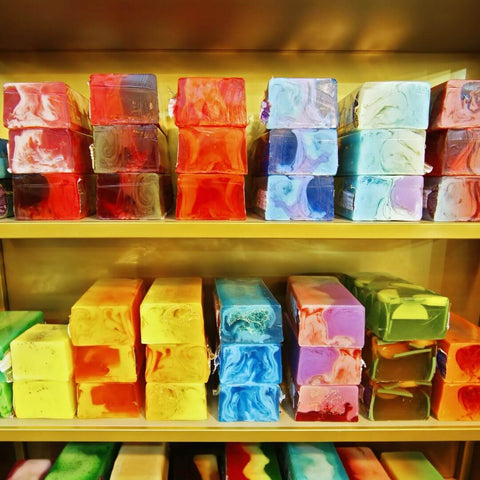THE MOST EFFECTIVE WAY TO ADD COLOR TO YOUR COLD PROCESS SOAP
Master the Art of Vibrant Soap Crafting with Mica Colors: Your Guide to Color Confidence!

Are your soap creations falling short on vibrancy? Do unpredictable color changes leave you frustrated? Say goodbye to common coloring woes with our guide to mastering color in cold process soap making.
Discover how to prevent color fading, morphing, bleeding, and staining with expert tips and techniques. Learn why mica colors reign supreme, offering stability, vibrancy, and non-bleeding properties. From achieving uniform distribution to unlocking a spectrum of hues, mica colors hold the key to consistent, captivating soap designs.
Elevate your soap game and conquer color challenges with confidence. Let's dive into the art of vibrant cold process soap making!
COMMON COLORING PROBLEMS IN COLD PROCESS SOAP MAKING
Color Fading: Loss of vibrancy over time due to exposure to light and air.
Color Morphing: Unexpected changes in color during the soap-making process.
Color Bleeding: Colors merging or running into each other, especially in layered soaps.
Staining: Colorants causing discoloration on surfaces or skin.
Color Separation: Uneven distribution of colorants leading to streaks or patches.
Unpredictable Color Changes: Variations in color outcome that are difficult to anticipate.

Overheating: Excessive heat during saponification, causing texture or color issues.
Incompatibility with Soap Formula: Colorants react negatively with soap ingredients.
Color Variation in Different Batches: Inconsistencies in color between different soap batches.
Difficulty Achieving Desired Colors: Challenges in achieving specific hues or shades desired in soap-making
HOW MICA COLORS HELP IN COLD PROCESS SOAP MAKING
Stability: Mica colors are known for their stability in alkaline environments, making them less likely to morph or change color during the saponification process.
Vibrancy: Mica colors often produce vibrant and eye-catching hues in soap, helping to maintain the desired color intensity even after curing.
Non-Bleeding: Mica colors are less likely to bleed into adjacent layers of soap, making them ideal for creating clean and crisp multi-colored designs.
Uniform Distribution: Mica powders disperse easily in soap batter, ensuring even distribution of color throughout the soap and reducing the risk of streaks or speckles.
Versatility: Mica colors come in a wide range of shades and can be easily blended to create custom colors, offering soap makers greater flexibility in achieving their desired color palette.
Compatibility: Mica colors are generally compatible with a wide range of soap ingredients, minimizing the risk of adverse reactions or color instability.
Longevity: Mica colors tend to retain their vibrancy over time, resulting in soap that maintains its aesthetic appeal even after prolonged use and storage.
By incorporating mica colors into your cold process soap recipes, you can effectively address many color-related challenges and achieve consistently beautiful results.

CONCLUSION
As passionate soap crafters, we understand the frustration of color woes that can plague your cold process creations. But fear not, fellow artisans! Armed with the knowledge shared in our guide, you can bid farewell to fading, bleeding, and unpredictable hues. Let's harness the power of mica colors - the unsung heroes of soap making - to infuse your creations with stability, vibrancy, and artistic flair. Embrace the artistry, elevate your soap game, and embark on a journey of vibrant, captivating creations. So, dear crafter, let's immerse ourselves in the colorful world of cold process soap making and unleash our creativity with confidence!




Leave a comment
This site is protected by hCaptcha and the hCaptcha Privacy Policy and Terms of Service apply.